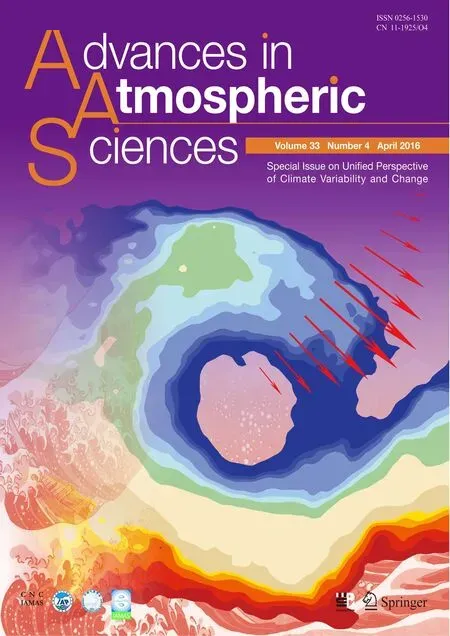The Fingerprint of Global Warming in the Tropical Pacific
Noel KEENLYSIDEand Dietmar DOMMENGET
1Geophysical Institute,University of Bergen/Bjerknes Center for Climate Research,Bergen 5007,Norway
2Nansen Environmental and Remote Sensing Center/Bjerknes Center for Climate Research,Bergen 5006,Norway
3ARC Centre of Excellence for Climate System Science,School of Earth,Atmosphere and Environment, Monash University,Clayton,VIC,Australia
The Fingerprint of Global Warming in the Tropical Pacific
Noel KEENLYSIDE?1,2and Dietmar DOMMENGET3
1Geophysical Institute,University of Bergen/Bjerknes Center for Climate Research,Bergen 5007,Norway
2Nansen Environmental and Remote Sensing Center/Bjerknes Center for Climate Research,Bergen 5006,Norway
3ARC Centre of Excellence for Climate System Science,School of Earth,Atmosphere and Environment, Monash University,Clayton,VIC,Australia
The impacts of global warming will be felt most strongly at regional scales.However,great uncertainties exist in climate change projections at these scales,limiting our ability to provide useful information for the planning and implementation of appropriate adaptation measures.Thus,there is an urgent need to reduce these uncertainties.
What determines regional climate change and how can we reduce uncertainties in the future climate projections at these scales?The new article by Ying et al.(2016)(p433 in this issue)makes an important contribution towards addressing the first part of this question for the Tropical Pacific and provides a framework for addressing the second part.Understanding the mechanisms for climate change is essential to provide confidence in model based future projections,especially given that the models exhibit many common systematic errors.
The Tropical Pacific is a key region for global climate,as diabatic heating released there through precipitation powers the atmospheric general circulation.Changes in precipitation patterns in the Tropical Pacific can,through atmospheric teleconnections,impact climate in distant regions.Furthermore,precipitation patterns in this region are closely related to the underlying sea surface temperature.
How global warming will impact precipitation and SST patterns in the Tropical Pacific is a subject of great scientific debate.Thermodynamic arguments predict that global warming will lead to a weakening of the Walker Circulation.In particular,the increased moisture carrying capacity of a warmer atmosphere will firstly lead to increased evaporation and precipitation,in what is known as a wet gets wetter and dry gets drier mechanism.The resulting greater diabatic heating at upper levels will act to stabilize the atmosphere,weakening the increase in precipitation and as a consequence also the atmospheric general circulation(Held and Soden,2006).However,the wet gets wetter picture holds mostly over the oceans, and even there is not able to explain many of projected regional changes(Chadwick et al.,2013).In particular,the strong coupled nature of ocean-atmosphere interaction in the tropics may modify this picture,and more recently,a warmer gets wetter hypothesis has been put forward where increases in tropical precipitation are collocated with the regions of greatest warming(Xie et al.,2010).Dynamical interactions,such as the Bjerknes feedback,may also play an important role in shaping the changes in the Tropical Pacific(Bayr et al.,2014).
Ying et al.focus on understanding how global warming will impact the SST and consider the two most commonly discussed patterns:The Eastern Pacific SST Warming(EPSW)and the equatorial peak warming(EPW).For this purpose they use the model simulations performed for the IPCC AR5.The multi-model mean predicts an El Ni?no-like warming.Going well beyond previous studies,they present a very careful analysis of the different terms driving upper ocean temperature in the multi-model ensemble mean.A key finding of their study is that the distribution of climatological latent heat flux is the most important term driving both the EPSW and EPW patterns.Ocean circulation changes tend to damp the EPSW,mostly through an equatorial upwelling feedback(Clement et al.,1996).In contrast,ocean circulation changes associated with a weakened Walker Circulation tend to enhance the EPW;this is a key difference to previous studies(Liu et al.,2005).
Importantly,Ying et al.(2016)'s approach can be extended to understand how model biases may impact the projected changes and to explain the factors causing the large intermodel spread.Such future work has the potential to reduce uncertainties in regional climate change in the Tropical Pacific,and in areas around the globe teleconnected to it.
REFERENCES
Bayr,T.,D.Dommenget,T.Martin,and S.Power,2014:The eastward shift of the Walker Circulation in response to global warming and its relationship to ENSO variability.Climate Dyn.,43,2747-2763.
Chadwick,R.,I.Boutle,and G.Martin,2013:Spatial patterns of precipitation change in CMIP5:Why the rich do not get richer in the tropics.J.Climate,26,3803-3822.
Clement,A.C.,R.Seager,M.A.Cane,and S.E.Zebiak,1996:An ocean dynamical thermostat.J.Climate,9,2190-2196.
Held,I.M.,and B.J.Soden,2006:Robust responses of the hydrological cycle to global warming.J.Climate,19,5686-5699.
Liu,Z.,S.Vavrus,F.He,N.Wen,and Y.Zhong,2005:Rethinking tropical ocean response to global warming:The enhanced equatorial warming.J.Climate,18,4684-4700.
Xie,S.P.,C.Deser,G.A.Vecchi,J.Ma,H.Teng,and A.T.Wittenberg,2010:Global warming pattern formation:Sea surface temperature and rainfall.J.Climate,23,966-986.
Ying,J.,P.Huang,and R.H.Huang,2016:Evaluating the formation mechanisms of the equatorial Pacific SST warming pattern in CMIP5 models.Adv.Atmos.Sci.,33(4),doi:10.1007/s00376-015-5184-6.
Keenlyside,N.and D.Dommenget,2016:The fingerprint of global warming in the Tropical Pacific. Adv.Atmos.Sci.,33(4),533-534,
10.1007/s00376-016-6014-1.
?Noel KEENLYSIDE,noel.keenlyside@uib.no
 Advances in Atmospheric Sciences2016年4期
Advances in Atmospheric Sciences2016年4期
- Advances in Atmospheric Sciences的其它文章
- Response of North Pacific Eastern Subtropical Mode Water to Greenhouse Gas Versus Aerosol Forcing
- Impact of the Pacific-Japan Teleconnection Pattern on July Sea Fog over the Northwestern Pacific:Interannual Variations and Global Warming Effect
- Change of Tropical Cyclone Heat Potential in Response to Global Warming
- The Southwest Indian Ocean Thermocline Dome in CMIP5 Models: Historical Simulation and Future Projection
- The Positive Indian Ocean Dipole-like Response in the Tropical Indian Ocean to Global Warming
- Historical Change and Future Scenarios of Sea Level Rise in Macau and Adjacent Waters
